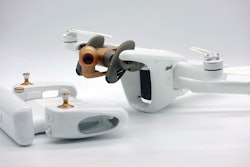
By Diego Barrera, Director of Professional Services at Skyward, A Verizon company
Drones have become an essential tool for construction and engineering, used for everything from aerial photography, surveying, mapping, GIS, thermal imaging, inspection and more. Some large organizations already employ dozens of pilots to maximize drone data at every step of the process. Improved workforce safety and risk reduction are two key factors driving the rapid adoption of drones in the building sector.
But it’s likely that even the best-run drone program will one day have a ground or flight incident: an equipment failure, a close call, a collision, a pilot injury, or maybe even a trespass into restricted airspace.
Does your company have internal reporting procedures to follow when it does? Every enterprise flying unscrewed aerial systems (UAS) needs a policy that spells out what happens when there’s an incident, just as airlines have reporting protocols for any breach of normal flight operations.
As the head of drone consulting at Skyward, I’ve defined four best practices to help companies report commercial drone incidents within their organizations. This article outlines optimal procedures to implement and follow:
- Create clear guidelines on instances that require reporting
- Define the incidents that don’t need to be reported
- Specify who gets notified when there’s an injury
- Create actionable reports, so your UAS program can continually improve
Why it's important to document and report drone incidents
A spirit of transparency around incident reporting starts with UAS managers. These leaders set the drone culture — for better or for worse — and it’s their job to make sure that people feel comfortable coming forward if something happens, and the UAV team learns from any mistakes. Start by making sure the full team understands why reporting flight incidents is essential:
- The company can’t protect itself — from embarrassment or liability — if management doesn’t know what happened. It’s smart to head off surprises, and it will help you retain executive support for the program.
- Unreported mistakes make it difficult to uncover any systemic flaws with equipment or operations. Pilots condemn their colleagues to repeating the same errors if managers can’t identify patterns. Sometimes, the remedies are a question of simple fixes, like better battery management, better pilot training or an extra step in a pre-flight planning checklist.
- Record what happened and allow for honest fact finding to enable continual improvement.
- Honesty is also important to protect the employees involved. If something happens and people in authority find out about it only after it’s become a real issue, this jeopardizes the program’s success.
Best practice 1: Develop guidance on what should be reported
There are both ground and flight incidents to consider in terms of internal reporting, including:
- Battery fires in the office
- Significant drone hardware failures (faulty propellers, early wear)
- Collisions with any structures
- Crashes
- Complaints due to flights that occur over people
- Wildlife disturbance (e.g., nests of endangered bird species)
- Injuries to your UAS team or bystanders caused by drone equipment
A typical reporting policy may read something like this:
Any accident or incident which meets the following criteria must be reported to the UAS Manager within 72 hours:
- Any injury to a third-party
- Any injury requiring more than first aid to a participant in the operation
- Any noticeable damage to property other than the UAS
- Substantial damage to or loss of company-operated or company-owned UAS
Best practice 2: State what type of incidents don’t need to be reported
No one likes a fuss over nothing. So tell your team which incidents don’t need to be reported. Also include guidance on what should go through your existing occupational safety reporting system, for example, a car accident on the way to the flight area. But if a propeller breaks, the drone is still airworthy, and you can repair it in the field, higher-ups probably don’t need to be bothered.
The UAS manager or responsible person should be the one who determines whether or not higher level reporting is required either to the FAA or to company leadership. Threshold limits for mandatory reporting vary by company. Incidents involving less than $1,000 of damage may not be worth it for some organizations to report internally. As you’re deciding on your policy, make sure it encourages full reporting whenever there’s a possibility that there may be an underlying operational issue at play. Just log the issue in your flight software so maintenance can be tracked as usual.
Best practice 3: Document who to notify when there’s an injury
It goes without saying, but I’ll say it anyway: If the drone incident involves an injury that requires more than first aid, call 911.
If your company has a safety or compliance office with an existing policy for reporting company accidents, that policy should be uploaded to your drone operations software for easy reference when there’s an injury. If no such protocols exist, check your software for an accident response checklist as a starting point.
You company policy should also specify who needs to be notified about drone-related injuries, for example:
- The site supervisor at the client jobsite, if there is one
- The chief pilot or UAS manager at your company
- The occupational safety or compliance department at your company
- The FAA, if the incident has caused a serious injury to any person or any loss of consciousness, or more than $500 in property damage other than the UAS
- Others who make sense; for example, if the police or fire department is involved
Best practice 4: Use reporting to prevent future incidents
Reports that only describe what happened without pinpointing the causes and creating accountability for fixes aren’t productive. Here’s how an incident report can serve as a tool for heading off recurring problems:
- The incident report should attribute the accident to specific factors. Each factor should have a recommendation for how to improve and to whom it’s assigned, along with a due date for taking action.
- Divide responsibilities for creating and responding to the report. The person who does an incident investigation should not necessarily be the same person who is charged with holding people accountable and following through on report recommendations. Keeping these assignments separate will help assure you get an impartial investigation. The resulting report can then be handed off to someone in the chain of command who can serve as a strong, unbiased advocate for implementing any recommendations.
Sample incident investigation and reporting policy
Once you’ve established your incident reporting protocol, be sure to add it to your drone operations software platform so you have quick access when you need it.
If your UAS operation is small and you need to do it yourself, here’s a sample policy as a template.
The UAS manager is responsible for ensuring that an internal accident safety report is completed within 21 calendar days of notification of any accident involving the company’s aircraft when:
- The aircraft is destroyed, lost or substantially damaged (ie, damage or failure which negatively affects the structural strength, performance or flight characteristics of the aircraft. This type of damage would normally require major repair or replacement.)
- There is any injury to a third party
- There is any injury to a [Company Name] staff member which requires more than first aid or results in a loss of consciousness
- There is claimed damage to the property of a customer caused by the operation
- There is claimed damage to the property of a third-party caused by the operation
Accident/Incident Reporting
National reporting requirements
1. The manager responsible for UAS operations will ensure that national accident or incident reporting requirements are met. Details may be found in the national requirements section of this policy.
Internal Reporting
1. Regardless of national requirements, the UAS must be notified whenever there is any accident or incident involving a Company owned or operated UAS which include:
1.1. Injuries to Company Employees: Causes an injury requiring treatment beyond first aid or loss of consciousness to a Company employee or contractor;
1.2. Injuries to Non-Company people: Causes an injury to someone who is not a Company employee or contractor;
1.3. Aircraft Damage: Substantially damages or destroys a UAS owned or operated by Company; or
1.4. Damage to Non-Company Owned Property: Causes noticeable damage to non-Company owned Property.
Safe commercial drone programs are built on aviation best practices. These practices are geared toward rigorous, standardized and repeated processes and a spirit of inquiry. Keep this in mind as you set up your organization’s standards for notifying company management of drone incidents. Don’t think of it as a punitive system but as an integral part of your successful UAS program.
Diego Barrera is a FAA Part107-certified drone pilot and director of professional services at Skyward, A Verizon company. He works with companies to set up safe, efficient drone programs and train drone pilots.


















